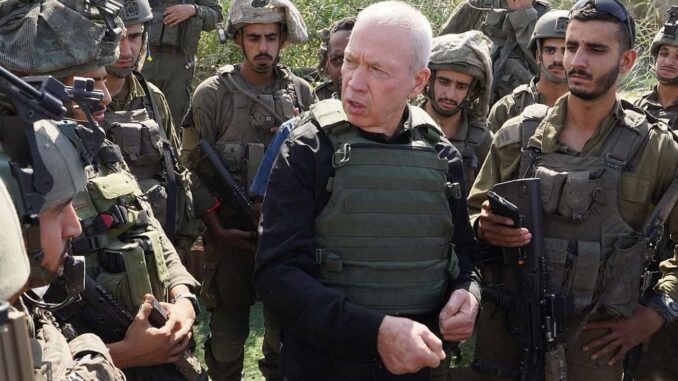The deadlock in negotiations for the release of Israeli captives, coupled with American accusations against the group, has paved the way for the offensive. Opinion.
By Meir Ben Shabbat, INN 1 May 2024

Meir Ben Shabbat
(JNS) As signs of an imminent IDF operation in Rafah intensify, there is growing concern that Israel will unnecessarily exercise self-imposed restraint by acting with insufficient force, so as not to upset the Biden administration, the Egyptians, or the ICC prosecutor at The Hague.
Meanwhile, Hamas is exploiting the prolonged waiting period and preparing well for the ground operation in this sector, which will undoubtedly pose complex operational challenges for the IDF. Despite the political pressures, Israel’s decision-makers must make it a top priority to attain the objectives with minimal risk to the lives of our forces.
The recent de-escalation with Iran allows Israel to shift its focus, without forfeiting political gains made, while continuing the fight against Hezbollah and dismantling terrorist networks in Judea and Samaria.
In this operation, the security establishment will be required to achieve five objectives:
• Dismantle Hamas’s regional brigade, with its four battalions, killing or arresting its commanders and most of its personnel, and seizing or destroying its command centers, strategic assets, weapons and production facilities, both above or below ground;
• Kill or arrest senior members of Hamas and Palestinian Islamic Jihad who fled from other areas to Rafah;
• End Hamas’s civilian control in this area, striking Hamas’s governing mechanisms including police and internal security forces, prisons and courts, as well as “civilian” committees for managing emergency affairs;
• Take control of smuggling routes and shaping a new security reality along the border strip, preventing smuggling from Sinai to the Gaza Strip; and
• Advance the release of the captives—either by seizing opportunities during the fighting or through negotiations following increased pressure on Hamas.

Def. Min. Gallant at Gaza border Oct 15, 2023Ariel Hermoni/Israel Ministry of Defense
The IDF and Hamas: Starting conditions
The IDF’s starting position for this operation is better than at the beginning of the campaign in the northern Gaza Strip or the Khan Yunis area.
First, the enemy will now be entering combat with a command echelon that has been depleted, with many fighters dead, wounded or arrested.
Second, its stockpile of weapons and ammunition has dwindled.
Third, its ability to strike the Israeli home front with rocket fire is rather limited.
And fourth, the IDF will have replenished its forces, updated its intelligence and improved its fighters’ operational combat worthiness through lessons learned from previous stages of the fighting.
However, from the enemy’s perspective, the overall picture also has some bright spots. Its force deployment in the combat zone has not only remained intact but has been reinforced with operatives from other areas. Its logistical preparedness has improved thanks to humanitarian aid entering the Strip, and it is equipped with fuel and food that allow prolonged survival in tunnels.
Additionally, the terrorists draw encouragement from the pressures exerted on Israel to minimize casualties and benefit from the involvement of Iran and its proxies, as well as the political support of Turkey and other countries. Above all, they are emboldened by their demonstrated ability to survive the IDF onslaught so far and the fact that even after 200 days of fighting, Hamas continues to be the central power in the Gaza Strip.
A formidable task
Alongside its offensive capabilities, the IDF will also need to strengthen its defense against various forms of attacks on its forces and on the home front that exploit proximity to borders or the use of tunnels. The same applies to the possibility that Hamas may carry out provocations in the border fence area and towards Sinai, aiming to create tensions between Israel and Egypt. Hints of this could be found in a statement issued this week by the “Palestinian factions.”
The IDF’s well-oiled war machine has proven itself, and there is no doubt as to its ability to handle this challenge as well. On the political level, maximum support and freedom of action are required to allow the IDF to employ intense firepower that will reduce the risk to our soldiers and bring about the swiftest possible defeat of the enemy.
Meanwhile, the IDF will need to continuously examine how the combat situation can be leveraged to advance the release of the captives.
The Rafah operation will not complete the task of decisively defeating Hamas. Even after it is over, much more work, and a deeper impact, will be needed inside the territory before Hamas’s remaining capabilities are destroyed and a new reality emerges. This was also the case following “Operation Defensive Shield” 22 years ago.
It will not be quick and easy, but it is necessary and possible.
Meir Ben Shabbat is head of the Misgav Institute for Zionist Strategy & National Security, in Jerusalem. He served as Israel’s national security advisor and head of the National Security Council between 2017 and 2021. Prior to that, for 25 years he held senior positions in the Israel Security Agency (Shabak).



https://www.timesofisrael.com/liveblog-may-03-2024/
Israel has the high ground